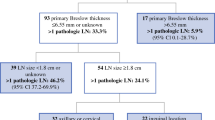Abstract
Background
It is common to obtain radiological studies around the time of a positive sentinel lymph node biopsy (SLNB) to exclude patients with distant metastases from completion lymph node dissection. The yield of such a work-up is unknown.
Methods
Patients were identified from a prospectively maintained database. Medical records were reviewed.
Results
Over an 8-year period, 181 patients had a positive SLNB. At least one study (computed tomography or magnetic resonance imaging of the brain; chest x-ray; computed tomography of the thorax, abdomen, or pelvis; positron-emission tomography scan; or bone scan) was obtained around the time of SLNB in 178 patients (98%). Studies were obtained after SLNB in 107 patients (59%). Studies ordered after SLNB resulted in indeterminate findings in 51 patients (48% of those studied). Among patients tested after SLNB, four were found to have metastatic disease (positive rate 3.7%). All of these patients had both a thick melanoma and macrometastasis within the SLN. The number of patients with indeterminate findings would be decreased and the yield of the work-up increased by 4 fold, by restricting the work-up to those with thick melanoma and macrometastasis.
Conclusions
Radiological studies obtained after a positive SLN produce indeterminate findings in about half of the patients and identify distant disease in 3.7%. Restricting work-up to patients with thick melanoma and macrometastasis on SLNB would spare patients from indeterminate findings and increase the yield of the evaluation.

Similar content being viewed by others
References
Gershenwald JE, Thompson W, Mansfield PF, et al. Multi-institutional melanoma lymphatic mapping experience: the prognostic value of sentinel lymph node status in 612 stage I or II melanoma patients. J Clin Oncol 1999; 17(3):976–83
Clary BM, Brady MS, Lewis JJ, Coit DG. Sentinel lymph node biopsy in the management of patients with primary cutaneous melanoma: review of a large single-institutional experience with an emphasis on recurrence. Ann Surg 2001; 233(2):250–8
Chao C, Wong SL, Ross MI, et al. Patterns of early recurrence after sentinel lymph node biopsy for melanoma. Am J Surg 2002; 184(6):520–4
Leong SP, Kashani-Sabet M, Desmond RA, et al. Clinical significance of occult metastatic melanoma in sentinel lymph nodes and other high-risk factors based on long-term follow-up. World J Surg 2005; 29(6):683–91
Dessureault S, Soong SJ, Ross MI, et al. Improved staging of node-negative patients with intermediate to thick melanomas (>1 mm) with the use of lymphatic mapping and sentinel lymph node biopsy. Ann Surg Oncol 2001; 8(10):766–70
Morton DL, Thompson JF, Cochran AJ, et al. Sentinel-node biopsy or nodal observation in melanoma. N Engl J Med 2006; 355(13):1307–17
Wong SL, Morton DL, Thompson JF, et al. Melanoma patients with positive sentinel nodes who did not undergo completion lymphadenectomy: a multi-institutional study. Ann Surg Oncol 2006; 13(6):809–16
Gershenwald JE, Buzaid AC, Ross MI. Classification and staging of melanoma. Hematol Oncol Clin North Am 1998; 12(4):737–65
Olson JA, Jr., Jaques DP, Coit DG, Hwu WJ. Staging work-up and post-treatment surveillance of patients with melanoma. Clin Plast Surg 2000; 27(3):377–90
Roth JA, Eilber FR, Bennett LR, Morton DL. Radionuclide photoscanning. Usefulness in preoperative evaluation of melanoma patients. Arch Surg 1975; 110(10):1211–2
Buzaid AC, Sandler AB, Mani S, et al. Role of computed tomography in the staging of primary melanoma. J Clin Oncol 1993; 11(4):638–43
Buzaid AC, Tinoco L, Ross MI, et al. Role of computed tomography in the staging of patients with local-regional metastases of melanoma. J Clin Oncol 1995; 13(8):2104–8
Kuvshinoff BW, Kurtz C, Coit DG. Computed tomography in evaluation of patients with stage III melanoma. Ann Surg Oncol 1997; 4(3):252–8
Hafner J, Schmid MH, Kempf W, et al. Baseline staging in cutaneous malignant melanoma. Br J Dermatol 2004; 150(4):677–86
Miranda EP, Gertner M, Wall J, et al. Routine imaging of asymptomatic melanoma patients with metastasis to sentinel lymph nodes rarely identifies systemic disease. Arch Surg 2004; 139(8):831–7
Wang TS, Johnson TM, Cascade PN, et al. Evaluation of staging chest radiographs and serum lactate dehydrogenase for localized melanoma. J Am Acad Dermatol 2004; 51(3):399–405
Libberecht K, Husada G, Peeters T, et al. Initial staging of malignant melanoma by positron emission tomography and sentinel node biopsy. Acta Chir Belg 2005; 105(6):621–5
Vereecken P, Laporte M, Petein M, et al. Evaluation of extensive initial staging procedure in intermediate/high-risk melanoma patients. J Eur Acad Dermatol Venereol 2005; 19(1):66–73
Wagner JD, Schauwecker D, Davidson D, et al. Inefficacy of F-18 fluorodeoxy-D-glucose-positron emission tomography scans for initial evaluation in early-stage cutaneous melanoma. Cancer 2005; 104(3):570–9
Brady MS, Akhurst T, Spanknebel K, et al. Utility of Preoperative [(18)]F Fluorodeoxyglucose-Positron Emission Tomography Scanning in High-Risk Melanoma Patients. Ann Surg Oncol 2006; 13(4):1–8
Clark PB, Soo V, Kraas J, et al. Futility of fluorodeoxyglucose F 18 positron emission tomography in initial evaluation of patients with T2 to T4 melanoma. Arch Surg 2006; 141(3):284–8
Aloia TA, Gershenwald JE, Andtbacka RH, et al. Utility of computed tomography and magnetic resonance imaging staging before completion lymphadenectomy in patients with sentinel lymph node-positive melanoma. J Clin Oncol 2006; 24(18):2858–65
Acland KM, Healy C, Calonje E, et al. Comparison of positron emission tomography scanning and sentinel node biopsy in the detection of micrometastases of primary cutaneous malignant melanoma. J Clin Oncol 2001; 19(10):2674–8
Author information
Authors and Affiliations
Corresponding author
Rights and permissions
About this article
Cite this article
Gold, J.S., Jaques, D.P., Busam, K.J. et al. Yield and Predictors of Radiologic Studies for Identifying Distant Metastases in Melanoma Patients with a Positive Sentinel Lymph Node Biopsy. Ann Surg Oncol 14, 2133–2140 (2007). https://doi.org/10.1245/s10434-007-9399-3
Received:
Accepted:
Published:
Issue Date:
DOI: https://doi.org/10.1245/s10434-007-9399-3




